Kurimanzutto since its beginning has been installed as one of the most avant-garde places in Latin America and the world, where the exhibition space goes beyond the white cube. Thus it was born “Sonora 128”, a project in which appropriates a corner of Mexico City, where a spectacular billboard will be exhibiting the artwork of four artists, the first was Wolfgang Tillmans, continuing with the colombian artist Antonio Caro. About this and more is that we talked with Bree Zucker, curator and programmer of this super project.
By Carolina Martínez Sánchez | Billboard images: courtesy of the artist and Kurimanzutto by PJ Rountree Portraits by PJ Rountree
Kurimanzutto has since its beginning differentiated itself through its curatorial direction, both within the white cube and its projects in the public space, thus creating different instances of communication between people, art and certain messages. How was the “Sonora 128″ project conceived and from where comes its inspiration?
In my opinion, kurimanzutto´s growth and progress as a gallery throughout its years and history, is due in large part to its mastermind ability to conceive of a flexible activity outside the box. Its early activities were an open, playful questioning of its context in time. This new project similarly functions in the same way. We were very much thinking about Mexico, above all, the young artists of the city, aka the upcoming generation. We were thinking of an art space as an active meeting point, a place where everyone is welcome (do we dream under the same sky?). As such Sonora 128 is a space that costs nothing to visit. It is open to interpretation, and its expectation is the unknown. When we conceived of Sonora 128, it was with the mission to expose fresh energy, with hope of catalyzing conversation and dialogue. I think of it as a source of free information for a general audience in the form of public art, and as such, this project proposes an alternative that is simultaneously social, political and aesthetic.
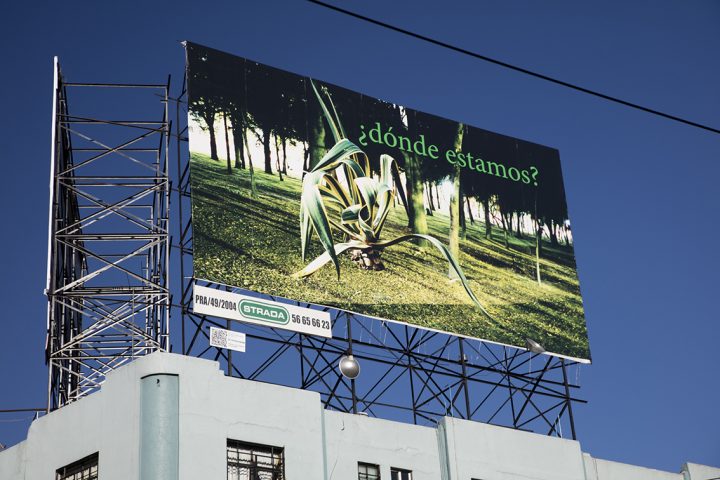
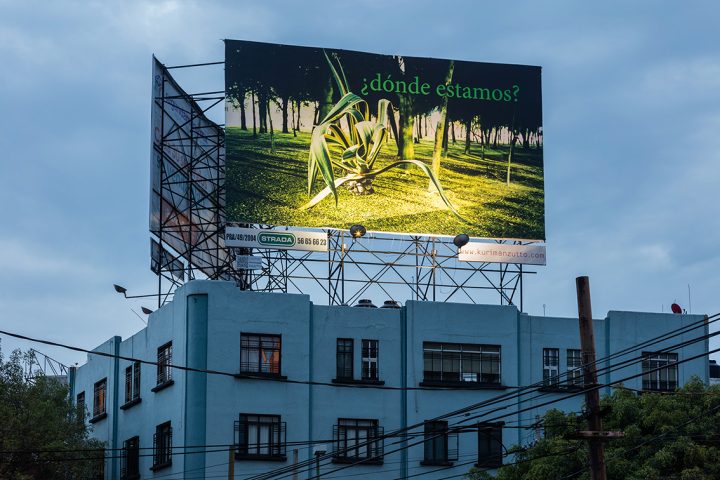
Was Sonora 128 originally planned as a billboard-based exhibition, or were other media considered? What informed this decision?
The project was always conceived as a billboard space. While sometimes a harbinger of visual noise and chaos in cosmopolitan cities, especially those with territorial laws or building rights shall we say “open to interpretation”, a billboard is indeed a special thing in that it is open and free to all. We were interested in appropriating the popular media of the city, a space that layers across Mexico in the daily grist, either pasted across facades, stacked one atop another, perched perilously on roofs, greeting you en route from the airport, or on the way home, or to see friends, or even going to nowhere, a sign in the sky, signaling to anyone who sees it. This billboard is thus an intervention and an installation. It is a 2D space dealing with 3D issues. It is something for everyone, and above all, is a one wall gallery (no floor, no ceiling, no bathroom), that in fact does not confine its spatial legibility to merely its architectural context. This is interesting for me. Additionally, I once thought that Mexico sorely lacked an artist bar, where one could come and interact with the different circles in the city, to argue, drink and discuss. Discussion and debate, are for me, the root of creativity. And for me, this space similarly provides an intersection for public attitudes, thoughts, perceptions, so it´s better than a bar.
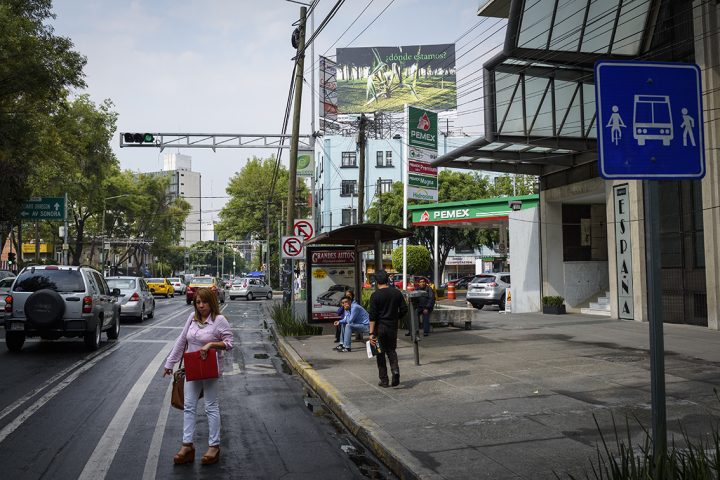
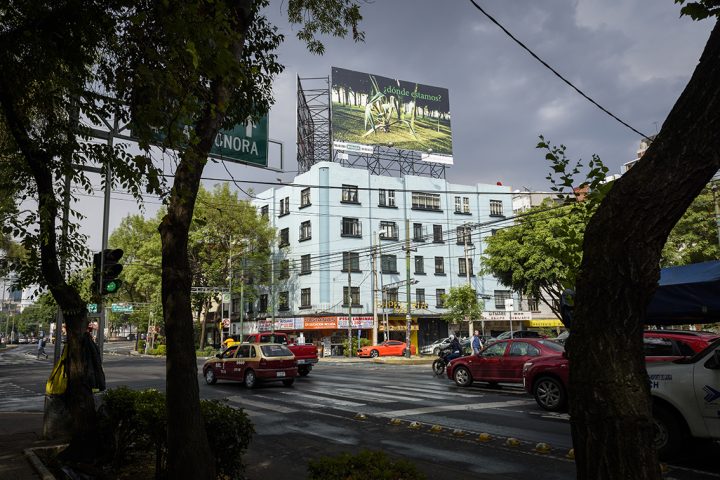
Tell me about curating; your selection criteria and what do you hope to provoke in the audience with each of the invited artists?
There are no rules or specific criteria for the selection of artists on the billboard. (Rule breaking is interesting, but then you have to break the rule breakers, etc.) We created this project as an alternative platform, for an alternative energy. So our hope is to generate something as yet unseen in the city, and that each artist will bring a different dynamic to their project. We rely on collaboration, ideas, and the strength of the artist’s perception and energy to underscore their work that appears on the billboard. From those we admire, we are searching for a certain instigatory spark, a light in the tunnel, a necessary kick in the ass, but hopefully not from a donkey.
How are the artworks of each of the invited artists linked?
We work directly with each artist, discussing and developing their idea in tandem with the particular context (in time and space) of Sonora 128. In some ways, one might think that the dimensions of the billboard provide a limited, flat format. But I am looking forward to future challenges that will make the space a social, physical one. For example , when we occupied Sonora 128 on March 1st 2016, we had the idea to celebrate with a flash flood in the surrounding park (Parque España). We still hope that such social elements come into play of future projects. Of course the space is also next to a gas station (very important) as well as 7-11, which has some truly lovely generic public seating with umbrellas which would be ideal for a discursive seminar.
Currently on display is “Dónde Estamos?” by Wolfgang Tillmans. How do you see this artwork and its contextual relationship (its aesthetic and contextual linking between the artist with the country)?
Wolfgang Tillmans is not a stranger to Mexico City. He was here in 2008 for a retrospective show at the Museo Tamayo and thus knows a bit its overlapping jungle environment. We knew he would be perfect To inaugurate the project because he is an artist who constantly and accurately takes the pulse of our times to a new level. Tillmans is a leader, endlessly creating new possibilities not just within his work, but as an activist, and as a artist who is not afraid to constantly transform. I see this particular work as being compositionally related to his posters and campaign against the Brexit vote. In those outwardly political posters (which are free for public use and dissemination), personal slogans are used to question the public, making individuals stop, think and consider their immediate reality as a community. Since the work on the billboard was simultaneously conceived during this upheaval in the UK, I understand ¿Dónde estamos? as related to the idea of a universal peace project, undergoing attack. But I also know that Tillmans was thinking about Gisela Mota, the mayor of Temixco, who vowed to oppose the narcos and as a result, was murdered on her first day of elected office. Tillmans was inspired to create a memorial (a fist and candle in the air) to her bravery. The cactus thus for me, is an incarnation of this memorial, but instead of appropriating, it collages Tillman´s imagery shot in Mexico. Tillmans saw the billboard as a social surface, on which to raise questions. We expressed to him the need to for a new energy in our current times, our impulse for togetherness, for freedom and liberation of artistic dialogue, and he provided us with a proposition, one which takes into account his own reflection on life. If the billboard is frustrating in its question, for me that is all the better. The problem with the nature of a photograph, is all too often, you feel you should immediately understand it. This work functions more like a landscape painting!
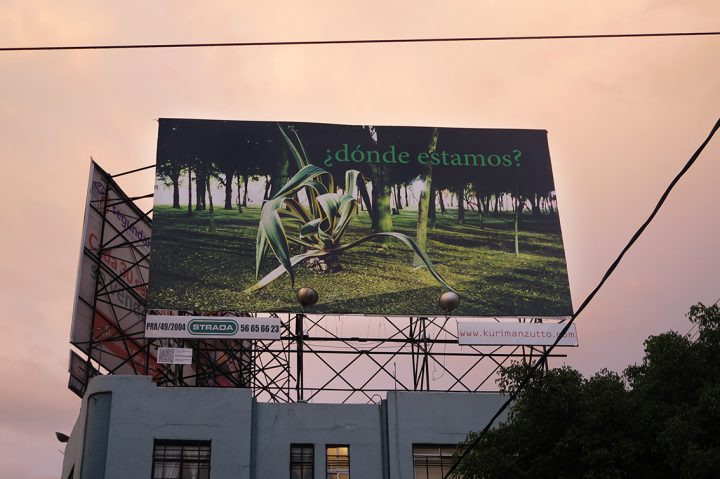
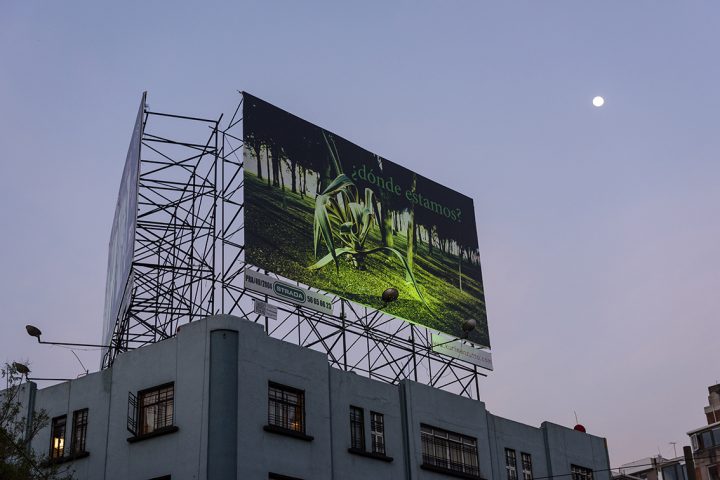
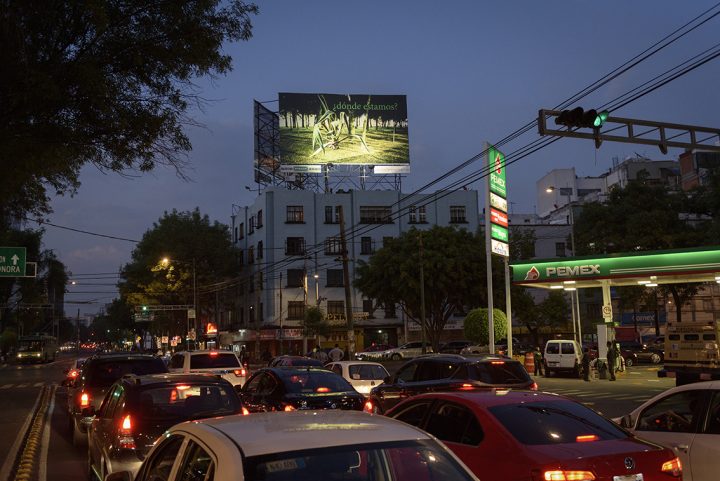
What sort of linkage and dialogue do you expect between “Sonora 128” and the audience, and at what levels?
I hope it catches their consciousness. I hope in five years, someone tells me they saw it, and either loved it or hated it, but that it stuck to them like unruly chewing gum. This is not a movie theater, it is not the point, nor in our interest, to stand at the entrance counting tickets. I believe this project goes past that precisely because it is public. But I do secretly hope this project appeals to someone like me, when I was younger, and seeking something…although I didn’t know then yet what…
How did you link with kurimanzutto coming from the publishing world? How did your different backgrounds affect your communication, as an artist, as a publisher and specifically with regard to your work with the gallery?
I am the co-editor of Ponytale Magazine, and for many years, I was a dedicated photographer. I came to the gallery because Monica Manzutto and Jose Kuri generously invited me to come and learn with them how to express ideas which I could not do on a printed page. I still believe that the two worlds are not so far apart. Both are the conceptualization of ideas in different forms, and both interest me in the ongoing drive to push thoughts and physically produce ideas at the forefront of a cultural dialogue. But the gallery was a challenge at the next level. I wanted to see things fly in the air.
What led you to work with the gallery? How do you project your interests there?
When I came to the gallery, I was very lucky to become part of a family, under the incredible mentorship of its founders, Monica and Jose. They have allowed me to grow wings, nurturing my opinions and my sense of self as an artist, while also giving me roots, helping me to learn the basic necessities of what it means to have a successful gallery, namely the daily administration and decisions that are part of being an effective businesswoman. Thus, at the gallery, I am involved in independent curatorial projects, as well as the day-to-day sales team, which is the core of the gallery.
For you, what is the importance of kurimanzutto and its relationship/dialogue with the current state of art?
I grew up hearing about the wild adventures of kurimanzutto. I really thought when I first came to Mexico in 2006, that I would finally find them (they didn’t have a fixed space) by seeing oranges in a window. In fact, I ended up walking the streets like a savage detective, and finally met Gabriel Orozco completely by chance at the airport on my way back to New York. Suffice to say, I have always had a very romantic notion from the get-go, that perhaps hooked me for life. When I came to the gallery, I learned even more about kurimanzutto´s history, their way of eating the city, their fearlessness in that era when the gallery was a rogue mobile nomad, devious, delightful, dancing with the devil. They were a gallery operating as an artwork and they were not only changing the rules, they were creating them. I entered the gallery professionally in another era, one where I truly believe kurimanzutto is the most powerful gallery in Latin America. As such, it has to continuously grow and challenge itself, and these challenges will not be the same as before. The gallery cannot go back, but forward. One benefit of this new era as a powerhouse is that it now has the ability to influence an entire generation of artists by creating a public project, even if they don´t yet know it…
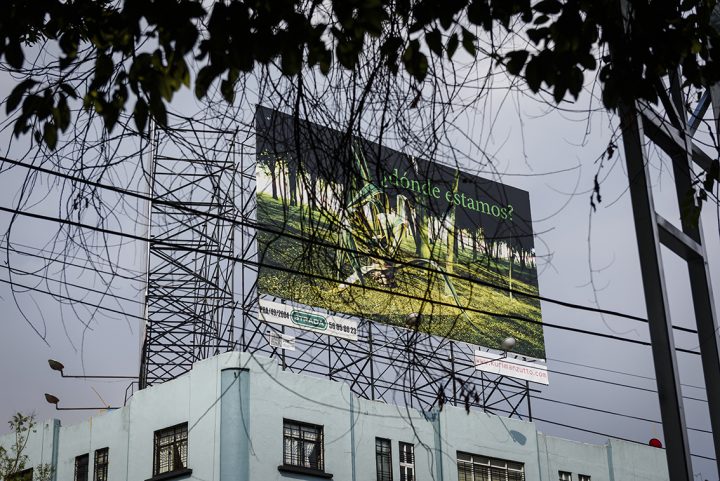
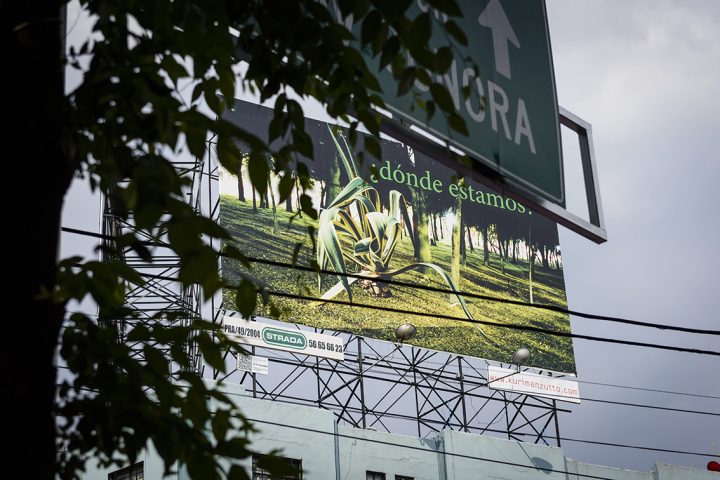
Today, in a world where so much is possible, and simultaneously, so much has already been made – in many cases allowing only for possible reinterpretations and reformulations – what would be the ways and means to generate pioneering artwork?
We never know the future until we see it.
What are your main markers that articulate the world of publishing, art and public space?
Word of mouth above all. Trust your friends, ask their opinions and learn to defend your own. And never let assholes come to dinner.
What and how is the impact of an artwork installed into the public space and how it relates to “artivism”?
I will quote our comrade Tillmans, when he says that, ¨through the every changing filter of time and context, the issue remains the same.¨ Public art has so many different inceptions. It can be like Richard Serra, who the public derided as destroying their plaza (only to have art enthusiasts later decry them as uneducated bourgeoise), or Félix González-Torres, whom almost everyone agrees is brilliant with his lovely, poetic, melancholic use of billboards as a visible stand-in for the invisible (AIDS, death, disappearance). Or it can be as Krystof Wodiczko, with his homeless projections reminding us of the uncanny. Or Gordon Matta-Clark, with his incisions and interventions…or it could be like the Mark di Suvero sculpture Joie de Vivre that very oddly became involved in Zuccotti Park and Occupy Wall Street and then had to be depoliticized by its owners… In short, as another friend once told me, public art functions as suspicious packages. We never know what is inside, nor how the public will react, nor what the outcome will be. But the point is that there is an impact.
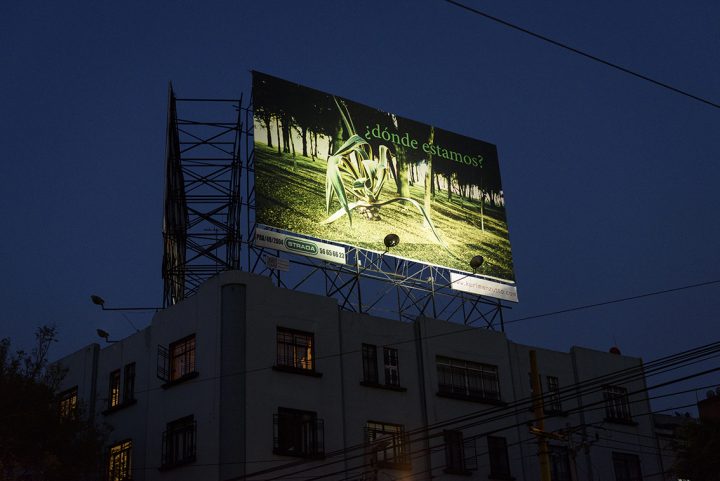
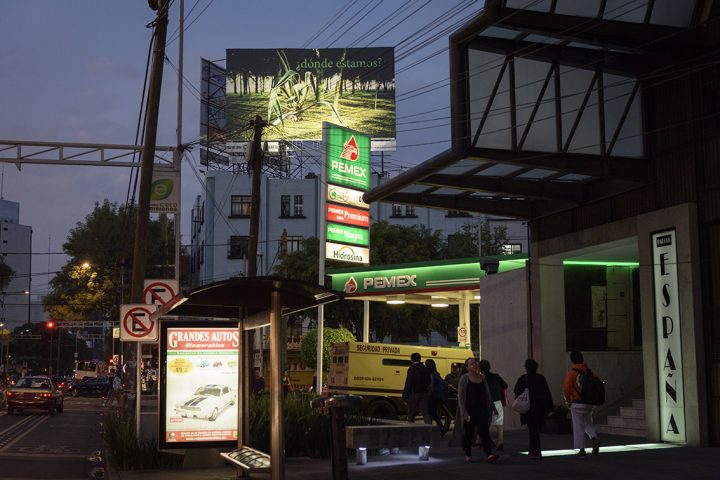
Is it possible to bring a change through such “artisivist” public art works on people and society?
Call me naïve, but I think so. I speak from my own Aristotelian coda of experience, but I cannot tell you how many times in life, that something I did not wish to see changed my perception and perspective. It is precisely scraps of unexpected knowledge, which were unasked for and perhaps never wanted (and which we may also reject), that have the power to affect us the most. That is the joy of being proven wrong. Anyway, if people do not want to go to art, or do not know where art is, or cannot go to the art, then art must go to the people. Otherwise we are all up shit creek without a paddle.
Gallery exhibition versus public space: is it essential to consider projects for the place that are planned for their presentation?
Yes, Sonora 128 is a space that depends on site-specific projects and promotes this idea. Or as Pogo says, we have seen the enemy and it is us.
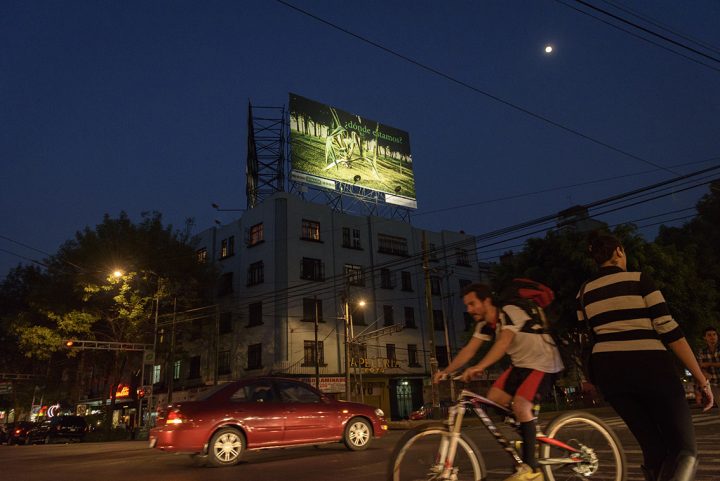
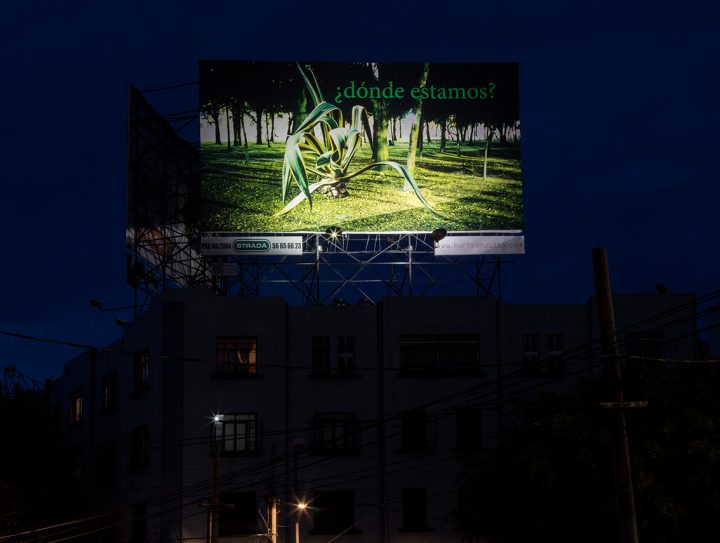
Why in the current times the viewer seems to be numbed and blind?
We are inundated with information. It assaults us from all sides, it climbs into our beds at night, it pervades our lives, beckons and seduces us with perpetual accessibility. However I believe in the active viewer. All of us are smart, conscious individuals. As they say, if you think the world is boring, it´s you.
Towards where are going the artworks and the art that wants interrupt to the individuals in their daily life?
Tactics and strategies will have to adapt to the time in which we live. The quotidian is an ever-present chameleon. Consumption, consumption of knowledge and humour above all are still weapons that can be harnessed to activate and surprise. Still, no matter the time, with all the passing centuries, the things that seem to impress us the most, in fact remind us of our own mortality.
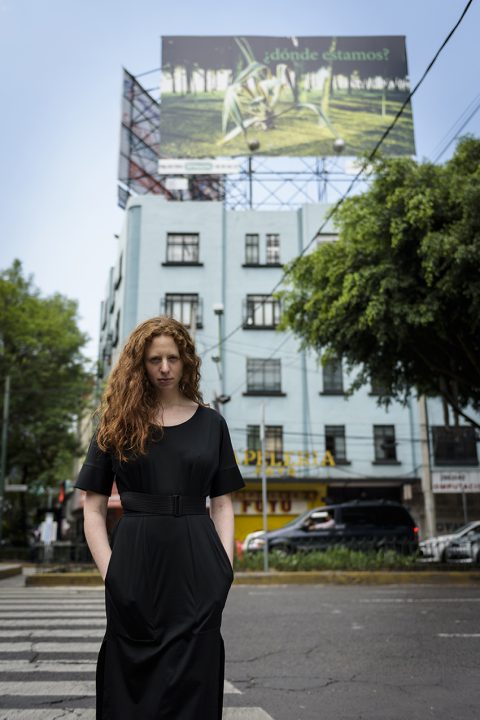

 Español
Español